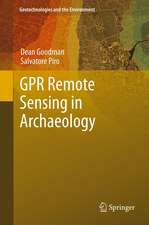Seismic Stratigraphy
Autor R. E. Sheriffen Limba Engleză Paperback – 31 ian 1980
Preț: 385.62 lei
Nou
Puncte Express: 578
Preț estimativ în valută:
73.81€ • 80.20$ • 62.04£
73.81€ • 80.20$ • 62.04£
Carte tipărită la comandă
Livrare economică 21 aprilie-05 mai
Preluare comenzi: 021 569.72.76
Specificații
ISBN-13: 9780934634519
ISBN-10: 0934634513
Pagini: 227
Ilustrații: 227 p.
Dimensiuni: 155 x 235 x 13 mm
Greutate: 0.36 kg
Ediția:Softcover reprint of the original 1st ed. 1980
Editura: SPRINGER NETHERLANDS
Colecția Springer
Locul publicării:Dordrecht, Netherlands
ISBN-10: 0934634513
Pagini: 227
Ilustrații: 227 p.
Dimensiuni: 155 x 235 x 13 mm
Greutate: 0.36 kg
Ediția:Softcover reprint of the original 1st ed. 1980
Editura: SPRINGER NETHERLANDS
Colecția Springer
Locul publicării:Dordrecht, Netherlands
Public țintă
ResearchCuprins
1 Introduction.- Stratigraphie Patterns in Seismie Data.- Seismie Stratigraphy Subdivisions.- Seismie Limitations.- Stratigraphie Traps.- 2 Processing for Stratigfraphic Interpretation.- Proeessing Objectives.- Examples of Proeessing Improvements.- Migration.- Wavelet Processing.- Summary.- 3 Seismic Sequence Analysis: The Geologic Models.- Geologic Sealevel Change Model.- Reflections as Constant Time Indicators.- Picking Seismic Sequences.- Alternate Concepts.- 4 Seismic Sequence Analysis: The Implementation.- Picking of Unconformities to Separate Seismic Sequences.- Mapping Seismic Sequences in Three Dimensions.- Examples.- Summary of Procedure.- 5 Seismic Facies Analysis and Reef Patterns.- Seismic Facies.- Types of Reflection Characteristics.- Examples.- Diiferent Concepts of Marine Onlap.- Classification Table for Clastic Facies.- Reef Patterns.- Distinguishing Characteristics of Reefs.- 6 Velocity and Resolution.- Velocity as a Diagnostic.- Measurement of Velocity.- Resolution.- Fresnel-Zone Effects.- 7 The Composition of a Seismic Trace: Modeling.- The Modehng Concept.- The Convolutional Model.- Reflectivity.- Forward Modeling: Synthetic Seismogram Manufacture.- Inverse Modeling: Seismic Log Manufacture.- Examples of Inversion.- 8 Reflection Character Analysis.- Simple Situations.- Amplitude as an Important Discriminant.- Case Studies.- Summary of Interpretation Procedures.- 9 Hydrocarbon Indicators.- Seismic Attributes.- Other Hydrocarbon Indicators.- Examples of Color-Attribute Interpretation.- Defining Reservoir Limits.- Summary of Hydrocarbon Indicators.- Envoi.- References.












